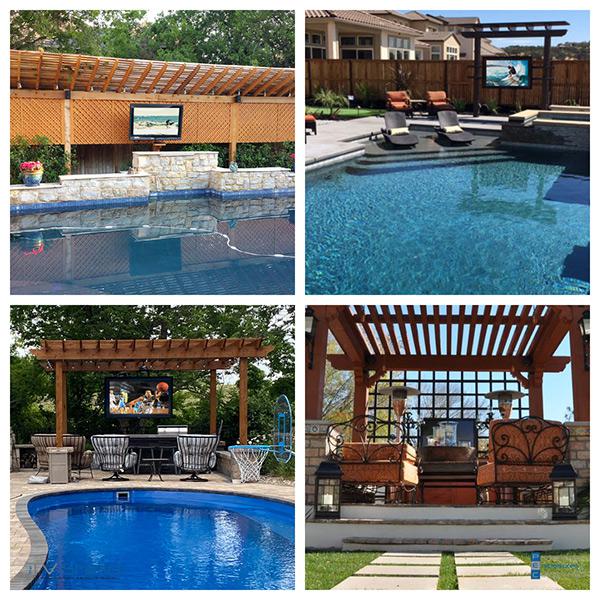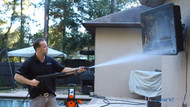Waterproof TV Guide & Best Options
Posted by Protective Enclosures Company on 26th Oct 2021
* This post was last updated 6-24-24 *

What is a Waterproof TV?
Is a waterproof TV completely water submergible? What does that term mean? Is there such a thing as a completely waterproof TV for outside? Are you looking for a waterproof or water-resistant TV (or monitor, LCD, OLED, etc.)? Technology has come a long way when it comes to putting TVs in harsh environments such as wet locations. This article covers what you need to know.
Article Table of Contents:
What is the Difference Between Water-Resistant and Waterproof?
What is the Best Waterproof TV Solution?
Which is the Best Water-Resistant TV Enclosure?
Are There Any Waterproof TVs?
The term waterproof is not the same as water submergible. We are aware of the possibility of fully submergible water TVs and digital displays on the market, but our understanding is they are extremely expensive and available more for specific commercial applications. We have seen other TV solutions that use the term waterproof, but so far when we call to ask… it turns out they are water-resistant rather water submergible.
Standard TVs and most outdoor TVs that are marketed as "waterproof" are not water submergible. Since some advertisers are now using the term outdoor waterproof TV referring to water-resistant, the terms waterproof and water-resistant often go hand in hand. Again, when shopping for weather resistant outdoor TVs or outdoor TV enclosures, note that waterproof and water-resistant are interchangeable terms which are completely different from water submergible. This article focuses on waterproof/water-resistant TV solutions. It is important to note that some are better than others. Read on to learn more.

Can Outdoor TVs Get Wet?
Outdoor TVs are designed to handle some light water exposure such as light rain or pool splashes. They are not designed to handle high amounts of rain such as very stormy weather. They are not made to withstand “pressure washers, high-pressure water jets, or hurricane-type weather,” (SnapAV). Instead, a high-quality weatherproof outdoor TV enclosure is an option that can handle extreme water exposure, including wash-downs and storms. Note that waterproof TVs for outside or TV enclosures are not designed to be completely water submerged unless otherwise stated.

What is the Difference Between Water-Resistant and Waterproof?
When it comes to TVs and TV enclosures, currently the terms waterproof and water-resistant are being used interchangeably. Some manufacturers use the terminology water-resistant rather than waterproof because TVs and TV enclosures are still not submergible in water. Unless otherwise stated, waterproof and water-resistant labeled TVs and TV enclosures are not water submergible. Be careful when shopping for products, because some manufacturers use the term waterproof, when really their product is minimally water-resistant. On the other hand, some manufacturers use the term water-resistant rather than waterproof even though their products offer the highest water-resistance on the market. Sometimes they use the term water-resistant rather than waterproof simply to clarify that their product cannot be fully submerged in liquid. Water-resistant and waterproof TVs or TV enclosures are likely to offer higher water protection when the enclosure has features like water-resistant sealing systems, cord entry grommets, fan filters, heater filters, and vent filters.
Weatherproof and water-resistant TVs and TV cabinets are built to withstand certain amounts of water exposure which varies depending on the product. In general, water-resistant TVs, simple TV cloth covers, or low-cost baseline plastic enclosures (like ABS enclosures) withstand minimal amounts of light rain and water exposure. On the other hand, robust but affordable waterproof outdoor TV enclosures like The TV Shield and The TV Shield PRO make of polycarbonate, HMWPE, and powder coated aluminum and steel are reinforced with advanced sealing systems so they can withstand harsh rain and wash-downs.

What is a Waterproof TV?
A waterproof TV is a water-resistant TV or a regular television paired with a water-resistant TV case which can withstand water exposure. There are varying levels of water-resistance depending on the TV or TV case, so it is important to fully read product details. For true water resistance against high water pressure or stormy environments, a waterproof TV enclosure with a strong sealing system, like The TV Shield’s ExactSeal Sealing System, is ideal for true protection against liquids. Water resistant TVs are becoming extremely popular. From pool decks, bathrooms, and party barges to restaurants patios and digital signage applications, outdoor waterproof TVs are used by both residential and commercial consumers across the globe. As explained earlier in this article, waterproof and water-resistant TVs and TV enclosures provide water resistance against things like rain and wash-downs, but they are not water submergible unless otherwise specifically stated by the manufacturer.
What is the Best Waterproof TV Solution?
Outdoor TVs are not made to withstand “pressure washers, high-pressure water jets, or hurricane-type weather,” ( SnapAV). So, a TV protection option, such as a weatherproof TV enclosure, is usually the best waterproof TV solution (which means water-resistant, not water submergible). Weatherproof TV enclosures protect TVs, displays, monitors, OLED, LED, LCD, digital menu boards, smart boards, electronic message boards, and more.

Which is the Best Water-Resistant TV Enclosure?
As of 2024, The TV Shield waterproof outdoor TV enclosures are used in over 34,000 locations in 55 countries.
It is important to understand the difference between different styles and materials when it comes to TV cabinets for outdoors. These cabinets are not, “all created equal,” as they say. Below are some materials and functions to be aware of as you search for the best weatherproof TV protection solution.
Design Options for Waterproof TV Cabinets (Sometimes Called Waterproof TV Enclosures)
The following are some key variations you may want to be aware of in general and when it comes to water-resistance as you explore different enclosures.

Front Shield Styles (TV Visibility) –
- Clear (for Direct TV Viewing) – Clear front shields always allow direct viewing without having to remove the front shield.
- Anti-Glare (for Direct TV Viewing) – Anti-glare front shields are especially helpful for providing a clearer picture in certain direct sun outdoor applications.
- Opaque (Must Be Removed to See the TV) – Some weatherproof TV cabinets are built with solid color front shields in front of the TV screen. This means the enclosure front shield needs to be removed each time for viewing.
Water-Resistance –
Water-Resistant Sealing Technology:
One thing to look for regarding water resistance is high quality sealing technology. As is visible in the photo below, red arrows point to the lip inside the front panel of a The TV Shield waterproof outdoor TV enclosure. That added lip protects from water intrusion. In contrast, the cheapest TV cases on the market are made from low-grade plastic and are usually basic plastic tubs that don’t feature advanced sealing features like the ExactSeal sealing system on The TV Shield.

Other Water-Resistant Features to Look for:
Other components to look for are things like grommets and vent filters. In addition to quality materials, added details such as grommets and filters are key components that make robust quality outdoor waterproof TV enclosures, such as The TV Shield, truly water-resistant even against harsh rain and wash-downs. The image below shows an example of a round grommet integrated with a cable passthrough on an outdoor TV cabinet.

Front Shield Materials –
- Glass
- UV Stabilized Polycarbonate
Glass or UV stabilized polycarbonate are the most common materials used for front shields on waterproof TV enclosures. They allow direct viewing through a protective front panel that prevents damage to the TV screen. On the other hand, some outdoor waterproof TV enclosures have opaque front shields that must be removed each time for viewing. Glass can be very clear, but costs typically run higher, and it is not completely shatterproof. In contrast, enclosures made with UV stabilized polycarbonate cost less, but still provide better durability because they are completely shatterproof, and they offer better sun defense for the TV inside the enclosure.
Back Frame or Housing Styles –
Back Frames – In most cases, enclosures that only have back frames rather than back housing are used in commercial applications and for mild outdoor exposure or indoor environments because they do not provide the same level of weatherproofing. But it is good to be aware they exist for certain needs.
Back Housing – Most enclosures have back housing, which is a solid tub into which a TV is placed. The tub is designed to protect the TV. It is good to know that various waterproof TV cabinet back housing options may have different materials, designs, and features. For most outdoor polymer enclosures, enclosures with embedded grooves and ribbing are ideal as they are much stronger than polymer enclosures without solid ribbing. However, powder coated aluminum and steel enclosures do not need ribbing.

Ready to Grab The TV Shield?
Now you know everything there is to know about waterproof TVs and water-resistant TV cabinets. You’re all set and equipped to navigate the options and decide the best solution for your needs.


